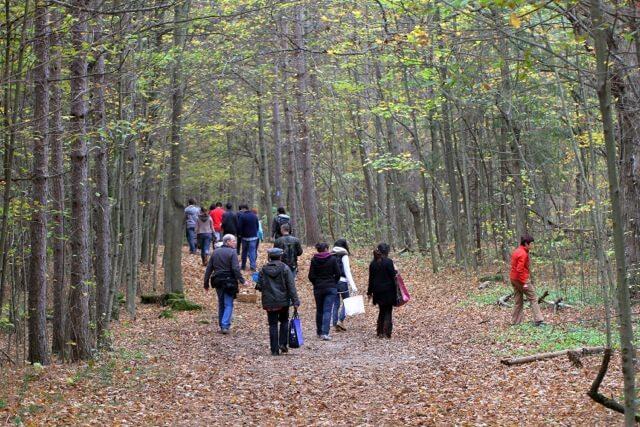- Even though he was among the first scientific researchers to probe the evolutionary advantages or a unique feature in the nucleus of some fungi called “dikaryon” – in which two nuclei are paired in each cell. (And he wrote a key chapter on this topic in a book titled “Sex in Fungi);
- And even though his colleagues credit him as one of the first to apply newly emerging molecular techniques to the study of fungi – examining nuclear and mitochondrial inheritance, ploidy, crosses, physical mapping of the genomes and spore germination. (These are very big deals in the world of mycology.);
- James Anderson will forever be known as the guy who in 1992 excited the whole world with his evidence and analysis that a fungus in Michigan that spreads 37 acres underground, weighs at least 21,000 pounds and is more than 1,500 years old. The “creature” became tourist attraction and inspiration for an annual mushroom-themed festival. There’s another one in Oregon that spreads 2,384 acres underground in making it likely the largest and oldest living organisms in the world.
While Anderson knew how big this fungus, Armillaria bulbosa, is, he had no idea how big a story it would be – how big a deal it would be forever.
UVM Emeriti Professor Bob Ullrich remembers back in ’92 when Anderson was about to publish in the journal “Nature,” the news about what was coined by “Natural History” magazine writer Stephen Jay Gould, “the humoungus fungus among us.”
And this shows how humble Anderson is. The University of Toronto public relations office had asked Anderson if he wanted them to field his phone calls for a few days. Naively, he wondered why. Beginning on the morning of publication and for several days he took constant phone calls from media from around the world, until he finally handed off the task to the PR office. The story is still told today.
It Took A Strong Foundation Built at UVM to Make Later Discovery
Anderson graduated in 1975 from the University of Rhode Island with a B.A. in biology. After a year as a research assistant at Brown University, he came UVM to earn his Ph.D. in botany in 1981. His work at UVM with Bob Ullrich on studies of mating biology helped him discover that the fungus Armillaria mellea is not once species but actually several closely related species. He then used molecular variation to document phylogenetic relationships among those species. These two contributions launched the large and active field of mushroom biogeography, and led to his discovery of that "humongous fungus," which captured the public's imagination shortly after his arrival at the University of Toronto at Mississauga.
"This would not have happened anywhere else but at UVM," Anderson said recently. "Bob Ullrich taught me the principle of strong inference in attacing a scientific problem. Bob was flexible in letting me go off on tangents, but he always brought me back to reality," he continued. "Phil Lintilhac's support and patience and generousity were also key in guiding my research and in learning how to represent it to a wider audience. For example, Phil listened to me practice my first speech four times, always with the question: 'how would you explain the science to the public on the six o'clock news," Anderson added, also giving a shout-out to professors Phil Cooke and Bud Etherton. Anderson credits UVM with charting the course that led to his longtime faculty position in Toronto.
There, in the 1990s, Anderson and his students conducted research on edible mushrooms useful to growers in the mushroom industry in Canada. His steady stream of research funding has come from the likes of Campbell Soup Company (think: cream of mushroom), the Canadian Mushroom Growers Association and Pfizer Canada, to name a few.
The 102 publications of his research have been cited nearly 4,000 times – exceptional marks for an evolutionary biologist.
He teaches advanced genetics and molecular biology. As with all academicians, he serves on committees and boards and mentors young researchers and undergrads. He counts 13 grad students and seven post-doc fellows as his own. Among his many honors, two are rare: he is an invited member of the American Academy of Microbiology and a recipient of the Distinguished Mycoloist award of the Mycological Society of America.
Latest Research Speaks to Drug Resistance
Now in his third decade the UT at Mississauga, where he became full professor in 1990, James Anderson collaborates with Linda Kohn on research on yeasts – documenting mutations that maintain species boundaries and that underlie adaptation to new environments and to antifungal drugs. The importance of this work inescapable, University of California-Berkley Professor John W. Taylor says. “It is not an exaggeration to say that Anderson has laid the foundations for two fields, fungal biogeography and experimental evolution of filamentous fungi.”
Or as Duke University Chair of Molecular Genetics and Microbiology Joseph Heitman says, “Jim Anderson is a highly accomplished and recognized fungal geneticist and biologist, and a mycologists' mycologist, with a deep love, appreciation, understanding and knowledge of the fungal kingdom.”
And as UVM CALS Dean Tom Vogelmann said on May 10 as he presented Anderson with one of the College’s highest honors, “UVM College of Agriculture and Life Sciences has the great good fortune to claim him as one of our own.”
"I'm glad to be back, but I felt like I never left, because I found such wonderful life-long colleagues here," Anderson replied, accepting the award.
Anderson and Kohn received the UVM College of Agriculture and Life Sciences (CALS) 2014 Outstanding Alumni Awards, along with Louise Calderwood, during CALS’ annual Alumni and Friends Award Dinner at the Davis Center on campus. Other awards presented were to New Achievers Shaun Gilpin and James Henley; Outstanding Senior Hillary Laggis and Sinclair Cup winner the late Kenneth “Stew” Gibson.
